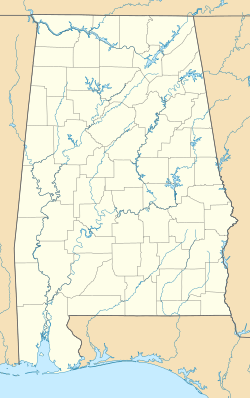Spring Villa facts for kids
Quick facts for kids |
|
|
Spring Villa
|
|

Spring Villa in 2010
|
|
| Nearest city | Opelika, Alabama |
|---|---|
| Built | 1850 |
| Architect | Younge, William Penn |
| Architectural style | Gothic Revival |
| NRHP reference No. | 78000494 |
| Added to NRHP | January 3, 1978 |
Spring Villa is a historic and beautiful old house located near Opelika, Alabama. It was built way back in 1850. This house is a great example of a special building style called Carpenter Gothic. It looks a bit like a fancy, old castle, but it was built as a home!
The house was designed with ideas from a famous architect named Andrew Jackson Downing. Spring Villa is one of only about 20 homes left in Alabama that show off this unique Gothic Revival architecture style. It was built by William Penn Yonge next to a large lake fed by a spring, which is how it got its name.
In 1927, the city of Opelika bought the house. Now, Spring Villa is the main building in a big park called Spring Villa Park. Because of its special design, it was added to the National Register of Historic Places on January 3, 1978. This means it's recognized as an important historical place.
What Makes Spring Villa Special?
Spring Villa is a one-and-a-half-story building made of wood. The front of the house has three main sections, called "bays." The roof runs straight across the front of the house. Each side of the main building has a pointed roof section, called a "gable." These gables are next to chimneys covered in a material called "stucco."
The upper part of the house has many steeply angled gables that cross each other. Each window on the top floor has its own small balcony in front of it. These balconies used to have a crisscross pattern, but now they have simple railings. Each gable is decorated with special trim called "bargeboards" and has a diamond-shaped decoration at the top, called a "pinnacle."
How the House Grew
At the back of the house, there's an attached section shaped like the letter "L," called an "ell." This part is also one-and-a-half stories tall. It has four sections on each long side and looks similar to the front of the main house. This "ell" was added in 1934 by a group called the Civil Works Administration. They added it when the house was being changed into a clubhouse for the city.
The Legend of Spring Villa
Spring Villa has a famous old story that many people talk about. Some say the house is haunted by the ghost of its first owner, William Penn Yonge. The legend says that Mr. Yonge was very strict with the people who worked for him.
The story tells of one person who was very angry with Yonge. This person supposedly hid one night in a small space above the 13th step of the house's spiral staircase. The legend claims that when Yonge reached the 13th step, the angry worker attacked him. For many years, a dark red stain, believed to be Yonge's blood, was said to be on that 13th step until the wood was finally repaired. Even today, visitors who tour the house are sometimes told to be careful not to step on that special spot!



